Abstract
We have evaluated the in vivo efficacy of anti-CD3-CRM9, a holo-immunotoxin constructed with a diphtheria toxin binding-site mutant. Eighty percent of established human T-cell subcutaneous tumors in nude mice completely regressed following intraperitoneal injection of immunotoxin at a dose set at half the minimum lethal dose assayed in toxin-sensitive animals. Similar regressions produced by a 137Cs source required a dose in excess of 500 cGy. The high degree of in vivo T-cell ablation produced by this immunotoxin is apparently due to maintenance of the toxin translocation function provided by CRM9 and a necessary intracellular routing function supplied by CD3. This immunotoxin may be useful in treating conditions caused by pathologic oligoclonal T-cell expansion such as graft-versus-host disease, autoimmune diseases, and possibly AIDS.
Full text
PDF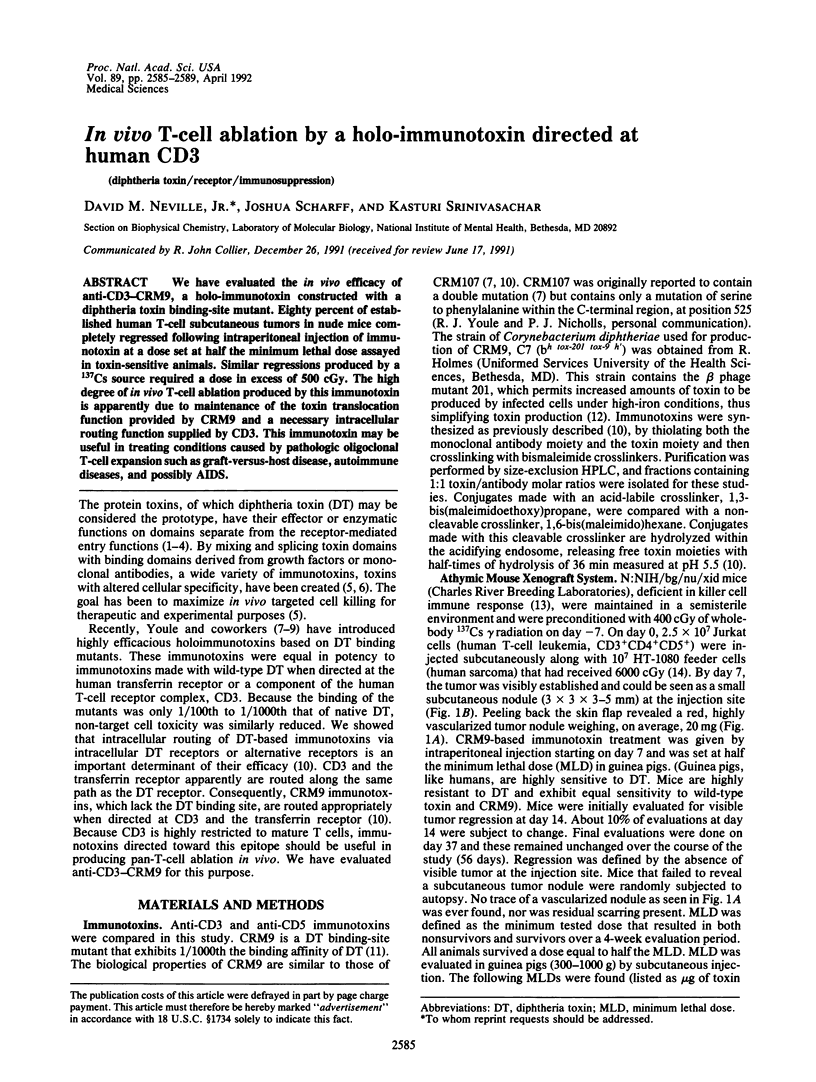
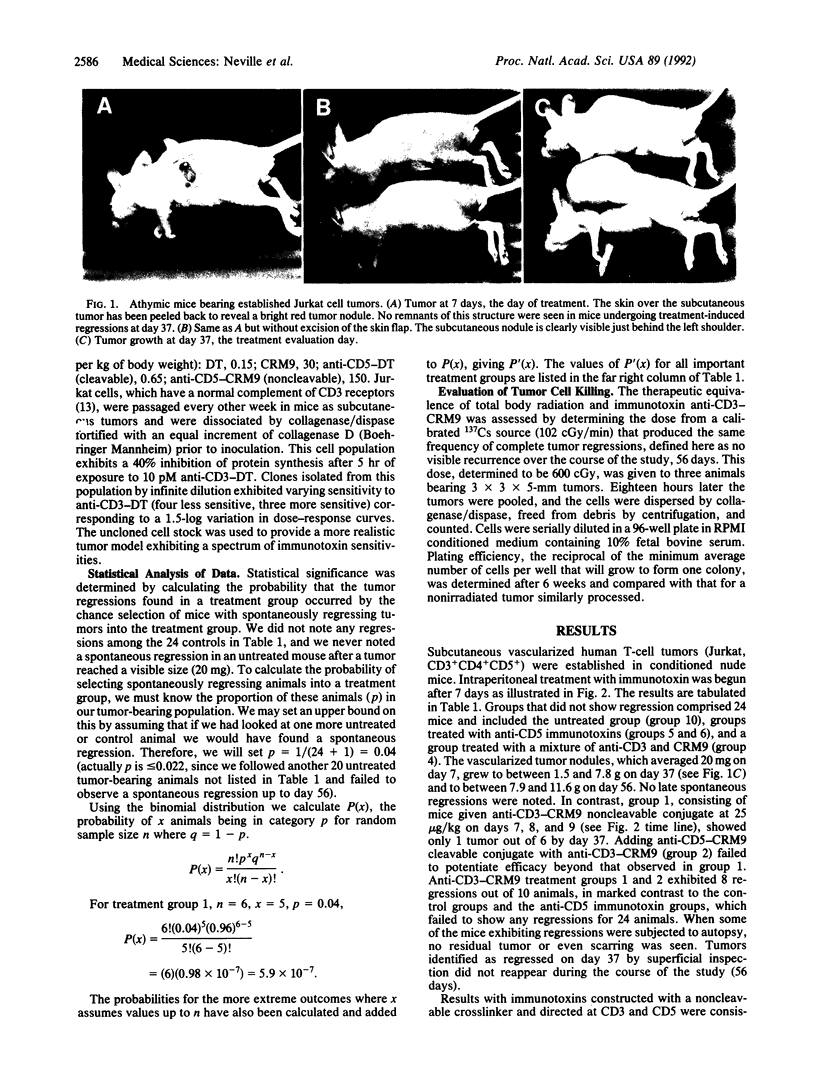
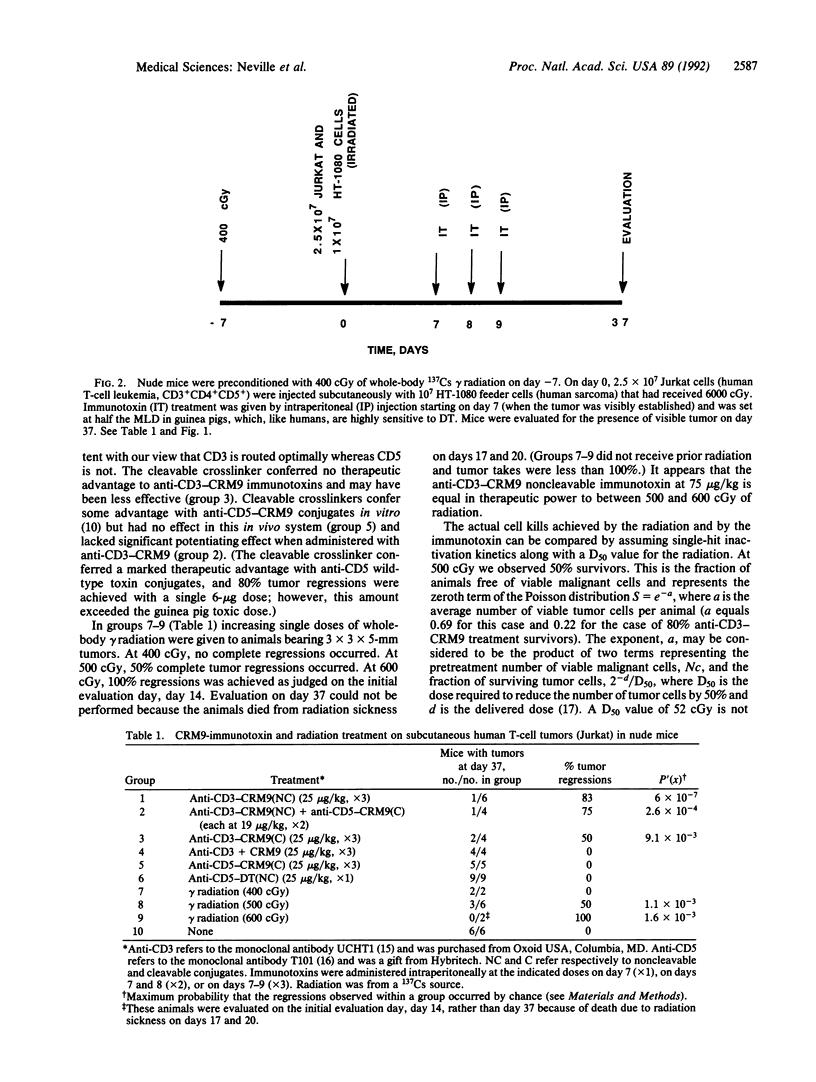
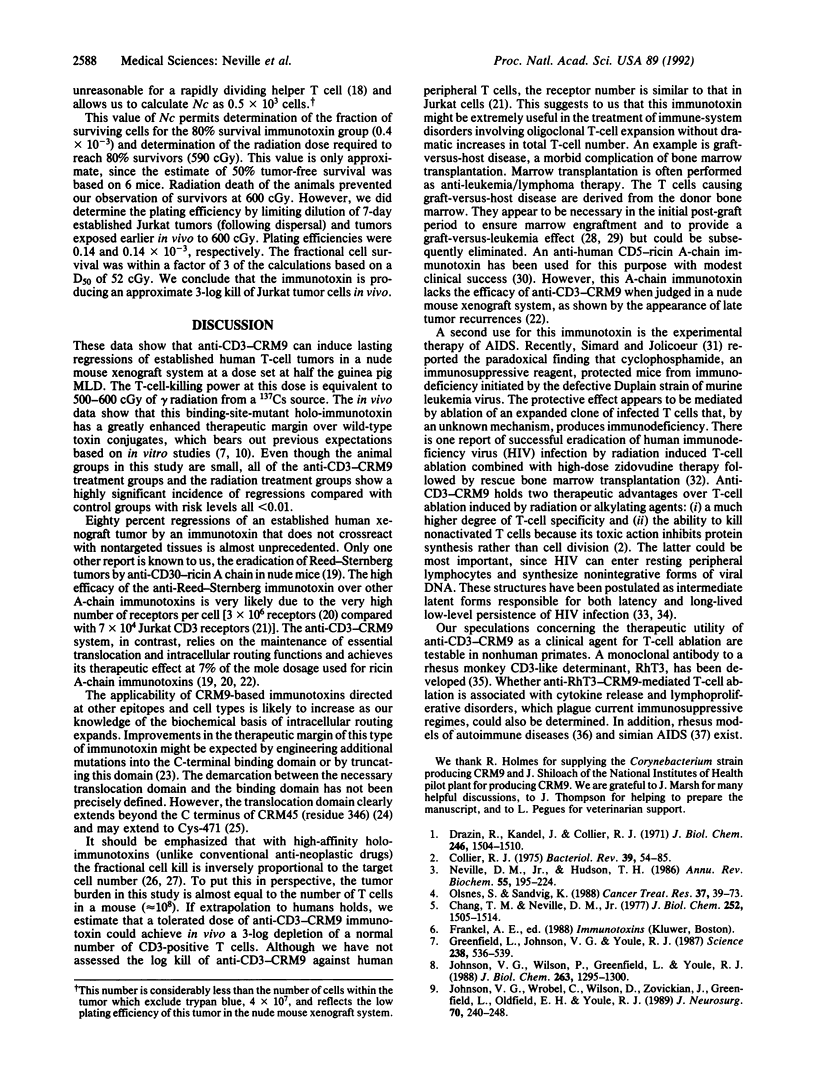
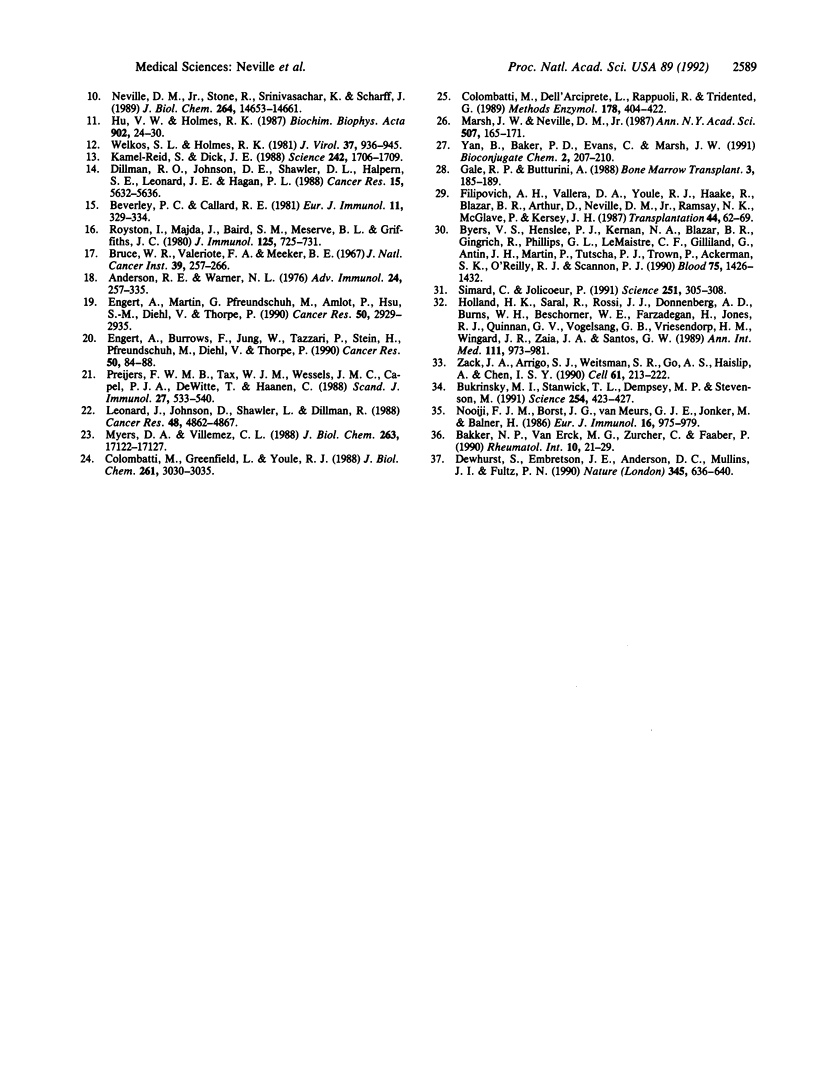
Images in this article
Selected References
These references are in PubMed. This may not be the complete list of references from this article.
- Anderson R. E., Warner N. L. Ionizing radiation and the immune response. Adv Immunol. 1976;24:215–335. doi: 10.1016/s0065-2776(08)60331-4. [DOI] [PubMed] [Google Scholar]
- Bakker N. P., van Erck M. G., Zurcher C., Faaber P., Lemmens A., Hazenberg M., Bontrop R. E., Jonker M. Experimental immune mediated arthritis in rhesus monkeys. A model for human rheumatoid arthritis? Rheumatol Int. 1990;10(1):21–29. doi: 10.1007/BF02274777. [DOI] [PubMed] [Google Scholar]
- Beverley P. C., Callard R. E. Distinctive functional characteristics of human "T" lymphocytes defined by E rosetting or a monoclonal anti-T cell antibody. Eur J Immunol. 1981 Apr;11(4):329–334. doi: 10.1002/eji.1830110412. [DOI] [PubMed] [Google Scholar]
- Bukrinsky M. I., Stanwick T. L., Dempsey M. P., Stevenson M. Quiescent T lymphocytes as an inducible virus reservoir in HIV-1 infection. Science. 1991 Oct 18;254(5030):423–427. doi: 10.1126/science.1925601. [DOI] [PMC free article] [PubMed] [Google Scholar]
- Butturini A., Gale R. P. T cell depletion in bone marrow transplantation for leukemia: current results and future directions. Bone Marrow Transplant. 1988 May;3(3):185–192. [PubMed] [Google Scholar]
- Byers V. S., Henslee P. J., Kernan N. A., Blazar B. R., Gingrich R., Phillips G. L., LeMaistre C. F., Gilliland G., Antin J. H., Martin P. Use of an anti-pan T-lymphocyte ricin a chain immunotoxin in steroid-resistant acute graft-versus-host disease. Blood. 1990 Apr 1;75(7):1426–1432. [PubMed] [Google Scholar]
- Chang T. M., Neville D. M., Jr Artificial hybrid protein containing a toxic protein fragment and a cell membrane receptor-binding moiety in a disulfide conjugate. I. Synthesis of diphtheria toxin fragment A-S-S-human placental lactogen with methyl-5-bromovalerimidate. J Biol Chem. 1977 Feb 25;252(4):1505–1514. [PubMed] [Google Scholar]
- Collier R. J. Diphtheria toxin: mode of action and structure. Bacteriol Rev. 1975 Mar;39(1):54–85. doi: 10.1128/br.39.1.54-85.1975. [DOI] [PMC free article] [PubMed] [Google Scholar]
- Colombatti M., Dell'Arciprete L., Rappuoli R., Tridente G. Selective immunotoxins prepared with mutant diphtheria toxins coupled to monoclonal antibodies. Methods Enzymol. 1989;178:404–422. doi: 10.1016/0076-6879(89)78030-7. [DOI] [PubMed] [Google Scholar]
- Colombatti M., Greenfield L., Youle R. J. Cloned fragment of diphtheria toxin linked to T cell-specific antibody identifies regions of B chain active in cell entry. J Biol Chem. 1986 Mar 5;261(7):3030–3035. [PubMed] [Google Scholar]
- Dewhurst S., Embretson J. E., Anderson D. C., Mullins J. I., Fultz P. N. Sequence analysis and acute pathogenicity of molecularly cloned SIVSMM-PBj14. Nature. 1990 Jun 14;345(6276):636–640. doi: 10.1038/345636a0. [DOI] [PubMed] [Google Scholar]
- Drazin R., Kandel J., Collier R. J. Structure and activity of diphtheria toxin. II. Attack by trypsin at a specific site within the intact toxin molecule. J Biol Chem. 1971 Mar 10;246(5):1504–1510. [PubMed] [Google Scholar]
- Engert A., Burrows F., Jung W., Tazzari P. L., Stein H., Pfreundschuh M., Diehl V., Thorpe P. Evaluation of ricin A chain-containing immunotoxins directed against the CD30 antigen as potential reagents for the treatment of Hodgkin's disease. Cancer Res. 1990 Jan 1;50(1):84–88. [PubMed] [Google Scholar]
- Engert A., Martin G., Pfreundschuh M., Amlot P., Hsu S. M., Diehl V., Thorpe P. Antitumor effects of ricin A chain immunotoxins prepared from intact antibodies and Fab' fragments on solid human Hodgkin's disease tumors in mice. Cancer Res. 1990 May 15;50(10):2929–2935. [PubMed] [Google Scholar]
- Filipovich A. H., Vallera D. A., Youle R. J., Haake R., Blazar B. R., Arthur D., Neville D. M., Jr, Ramsay N. K., McGlave P., Kersey J. H. Graft-versus-host disease prevention in allogeneic bone marrow transplantation from histocompatible siblings. A pilot study using immunotoxins for T cell depletion of donor bone marrow. Transplantation. 1987 Jul;44(1):62–69. doi: 10.1097/00007890-198707000-00015. [DOI] [PubMed] [Google Scholar]
- Greenfield L., Johnson V. G., Youle R. J. Mutations in diphtheria toxin separate binding from entry and amplify immunotoxin selectivity. Science. 1987 Oct 23;238(4826):536–539. doi: 10.1126/science.3498987. [DOI] [PubMed] [Google Scholar]
- Holland H. K., Saral R., Rossi J. J., Donnenberg A. D., Burns W. H., Beschorner W. E., Farzadegan H., Jones R. J., Quinnan G. V., Vogelsang G. B. Allogeneic bone marrow transplantation, zidovudine, and human immunodeficiency virus type 1 (HIV-1) infection. Studies in a patient with non-Hodgkin lymphoma. Ann Intern Med. 1989 Dec 15;111(12):973–981. doi: 10.7326/0003-4819-111-12-973. [DOI] [PubMed] [Google Scholar]
- Hu V. W., Holmes R. K. Single mutation in the A domain of diphtheria toxin results in a protein with altered membrane insertion behavior. Biochim Biophys Acta. 1987 Aug 7;902(1):24–30. doi: 10.1016/0005-2736(87)90132-5. [DOI] [PubMed] [Google Scholar]
- Johnson V. G., Wilson D., Greenfield L., Youle R. J. The role of the diphtheria toxin receptor in cytosol translocation. J Biol Chem. 1988 Jan 25;263(3):1295–1300. [PubMed] [Google Scholar]
- Johnson V. G., Wrobel C., Wilson D., Zovickian J., Greenfield L., Oldfield E. H., Youle R. Improved tumor-specific immunotoxins in the treatment of CNS and leptomeningeal neoplasia. J Neurosurg. 1989 Feb;70(2):240–248. doi: 10.3171/jns.1989.70.2.0240. [DOI] [PubMed] [Google Scholar]
- Kamel-Reid S., Dick J. E. Engraftment of immune-deficient mice with human hematopoietic stem cells. Science. 1988 Dec 23;242(4886):1706–1709. doi: 10.1126/science.2904703. [DOI] [PubMed] [Google Scholar]
- Leonard J. E., Johnson D. E., Shawler D. L., Dillman R. O. Inhibition of human T-cell tumor growth by T101-ricin A-chain in an athymic mouse model. Cancer Res. 1988 Sep 1;48(17):4862–4867. [PubMed] [Google Scholar]
- Marsh J. W., Neville D. M., Jr Development of an immunotoxin with in vivo efficacy for murine systems. Ann N Y Acad Sci. 1987;507:165–171. doi: 10.1111/j.1749-6632.1987.tb45799.x. [DOI] [PubMed] [Google Scholar]
- Myers D. A., Villemez C. L. Specific chemical cleavage of diphtheria toxin with hydroxylamine. Purification and characterization of the modified proteins. J Biol Chem. 1988 Nov 15;263(32):17122–17127. [PubMed] [Google Scholar]
- Neville D. M., Jr, Hudson T. H. Transmembrane transport of diphtheria toxin, related toxins, and colicins. Annu Rev Biochem. 1986;55:195–224. doi: 10.1146/annurev.bi.55.070186.001211. [DOI] [PubMed] [Google Scholar]
- Neville D. M., Jr, Srinivasachar K., Stone R., Scharff J. Enhancement of immunotoxin efficacy by acid-cleavable cross-linking agents utilizing diphtheria toxin and toxin mutants. J Biol Chem. 1989 Sep 5;264(25):14653–14661. [PubMed] [Google Scholar]
- Nooij F. J., Borst J. G., Van Meurs G. J., Jonker M., Balner H. Differentiation antigens on rhesus monkey lymphocytes. I. Identification of T cells bearing CD3 and CD8, and of a subset of CD8-bearing cells. Eur J Immunol. 1986 Aug;16(8):975–979. doi: 10.1002/eji.1830160817. [DOI] [PubMed] [Google Scholar]
- Olsnes S., Sandvig K. How protein toxins enter and kill cells. Cancer Treat Res. 1988;37:39–73. doi: 10.1007/978-1-4613-1083-9_4. [DOI] [PubMed] [Google Scholar]
- Preijers F. W., Tax W. J., Wessels J. M., Capel P. J., De Witte T., Haanen C. Different susceptibilities of normal T cells and T cell lines to immunotoxins. Scand J Immunol. 1988 May;27(5):533–540. doi: 10.1111/j.1365-3083.1988.tb02380.x. [DOI] [PubMed] [Google Scholar]
- Royston I., Majda J. A., Baird S. M., Meserve B. L., Griffiths J. C. Human T cell antigens defined by monoclonal antibodies: the 65,000-dalton antigen of T cells (T65) is also found on chronic lymphocytic leukemia cells bearing surface immunoglobulin. J Immunol. 1980 Aug;125(2):725–731. [PubMed] [Google Scholar]
- Simard C., Jolicoeur P. The effect of anti-neoplastic drugs on murine acquired immunodeficiency syndrome. Science. 1991 Jan 18;251(4991):305–308. doi: 10.1126/science.1987646. [DOI] [PubMed] [Google Scholar]
- Welkos S. L., Holmes R. K. Regulation of toxinogenesis in Corynebacterium diphtheriae. I. Mutations in bacteriophage beta that alter the effects of iron on toxin production. J Virol. 1981 Mar;37(3):936–945. doi: 10.1128/jvi.37.3.936-945.1981. [DOI] [PMC free article] [PubMed] [Google Scholar]
- Yan B., Baker P. D., Evans C. H., Marsh J. W. Influence of endogenous Thy1.1 cells upon the efficacy of an anti-Thy1.1 antibody-diphtheria toxin conjugate. Bioconjug Chem. 1991 Jul-Aug;2(4):207–210. doi: 10.1021/bc00010a003. [DOI] [PubMed] [Google Scholar]
- Zack J. A., Arrigo S. J., Weitsman S. R., Go A. S., Haislip A., Chen I. S. HIV-1 entry into quiescent primary lymphocytes: molecular analysis reveals a labile, latent viral structure. Cell. 1990 Apr 20;61(2):213–222. doi: 10.1016/0092-8674(90)90802-l. [DOI] [PubMed] [Google Scholar]



